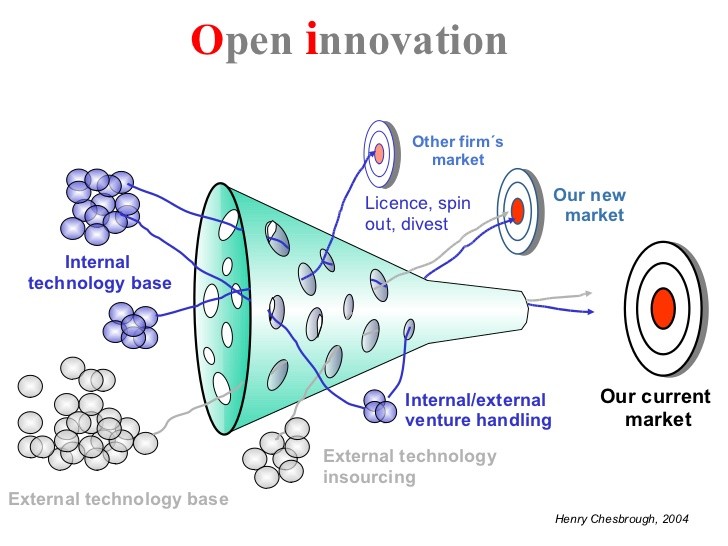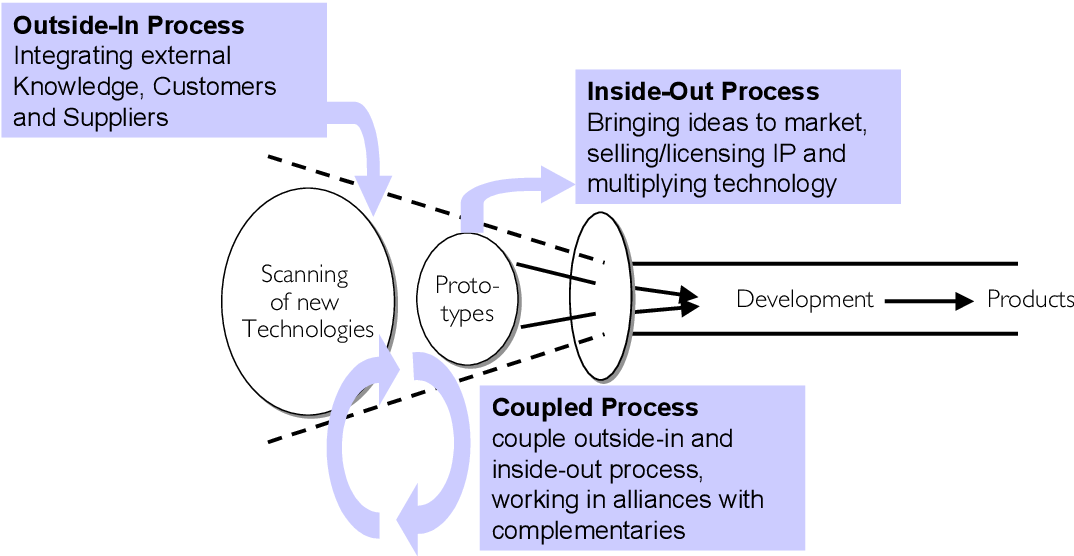As the world advances at an increasingly rapid pace, so does the need for innovation. However, this growing complexity makes innovation more difficult to pursue, especially for one person alone.
Despite this, the myth of the lone genius remains, with some organisations believing they can innovate in isolation, without any external input. But no organisation can thrive on its own.
The most transformative innovations result from collaboration and the collective effort of many individuals. To believe that an organisation can independently create breakthrough innovations and possess all the necessary knowledge, skills, and expertise is unrealistic.

Co-creation and collaboration have become essential, and Open Innovation offers a way to bring together diverse perspectives, expertise, and approaches. Open Innovation platforms are a key tool in facilitating this process.
In this article, we will explore the main functions of Open Innovation, different types of platforms, and their benefits.
Although Open Innovation is widely recognised, its practical and theoretical applications can be misunderstood. This gap between theory and practice exists because Open Innovation can take many forms in the real world.
In essence, Open Innovation refers to how companies draw on external knowledge, ideas, and expertise to enhance their innovation efforts. This can involve integrating new technologies, business models, and trends into a company’s own processes. It spans activities from gathering customer feedback to building more complex ecosystems of knowledge-sharing and co-creation.
In practice, Open Innovation involves a broad range of activities where information flows across organisational boundaries. From this perspective, its potential is vast.
The concept of Open Innovation was first introduced by Henry Chesbrough 20 years ago in his book Open Innovation: The New Imperative for Creating and Profiting from Technology. Chesbrough challenged the traditional closed innovation model, in which companies relied solely on internal research and development, advocating instead for the adoption of external ideas and collaborations.
By embracing Open Innovation, organisations can improve competitiveness, increase market share, and enhance their processes. While closed innovation depends on internal expertise, Open Innovation recognises the value that external collaborators can bring to achieving strategic goals. Sharing knowledge and intellectual property can be beneficial to all parties involved.
It’s important to understand that open and closed innovation each have their place. Rather than choosing one over the other, organisations must identify when to leverage both to maximise their potential.
Open Innovation is not a complex science, but it requires a structured approach. Success depends on creating the right environment, systems, and processes to support long-term collaboration. To tap into the creativity and knowledge of external sources, companies need to adopt an open mindset and understand the tools available for facilitating this type of innovation.

Three archetypes of open innovation processes (Gassmann & Enkel, 2004)
Types of Open Innovation.
Open Innovation Platforms are tools designed to support and streamline collaboration between organisations or individuals. Depending on your specific goals, there are various types of open innovation platforms available.
Chesbrough’s framework identifies three models of Open Innovation (learn more here):
Outside-in (inbound) model. This approach brings external knowledge into the organisation to fuel growth. It can involve partnerships with other companies, suppliers, public research institutions, or industry experts.
Inside-out (outbound) model. This approach focuses on using an organisation’s internal resources to improve processes, products, or services with external support. Some companies use this method for intrapreneurship programs or innovation incubators.
Coupled model. This combines both inbound and outbound strategies, integrating internal and external knowledge to create new value.
There are several different types of Open Innovation Platforms, each with its own features and focus. Selecting the right one depends on your organisation’s specific needs and objectives.
Idea Management Platforms. These are used to collect, evaluate, and develop ideas from stakeholders. They can be applied in Open Innovation or more broadly across other types of innovation processes.
Crowdsourcing Platforms. These tap into the collective intelligence of a large group, often external to the organisation. They help companies solve problems and generate new ideas by leveraging a wide range of contributors.
Scouting Platforms. These function as marketplaces for innovation, connecting organisations with potential partners who have the technology, expertise, or services they need. Novable is the perfect example.
Open Data Platforms. These provide access to large datasets, which can be used to identify industry trends, economic indicators, or potential risks and opportunities.
Open Innovation Platforms offer the ability to significantly broaden your audience. To gain deeper insights into consumer behaviour and maximise input, you can extend participation to a virtually limitless number of people. The right platforms provide the scalability to grow alongside your innovation efforts, making it just as feasible to gather feedback from 1,000 participants as it is from 100,000 when needed.
A great example of this is Lego’s Ideas Site, which allows the company to interact with fans and customers worldwide. Through this platform, users share ideas for new products, giving Lego valuable insights into customer preferences and generating fresh, innovative concepts.
In a closed innovation model, a company’s ability to solve challenges is restricted to the knowledge and expertise of its internal workforce.
In contrast, Open Innovation allows organisations to engage with external participants, including customers, suppliers, partners, and even the broader public.
Open innovation Platforms can be customised to attract specific contributors, such as industry experts or individuals with specialised skills. This focused approach ensures that the most relevant and knowledgeable participants are involved in the innovation process.
Open Innovation Platforms offer access to a broad range of ideas and a variety of expertise, enabling more informed decision-making. With the right platform, companies can develop innovation processes that are flexible and iterative, allowing for rapid testing and validation of ideas.
In contrast, closed innovation confines all activities within the organisation, often limiting openness to new ideas and experimentation. By embracing external input, companies can benefit from fresh perspectives and alternative approaches, discovering solutions they may not have otherwise explored.
The cost of innovation has reached new heights, and research shows that despite significantly higher R&D investments, the results have not improved proportionally.
Open Innovation Platforms can help reduce R&D expenses by offering more affordable solutions. Companies can foster internal innovation and empower their teams to develop new ideas.
In tough times, businesses often cut back on R&D spending and halt innovation initiatives. It becomes difficult to justify risky investments that may not guarantee long-term returns, especially when the future is uncertain.
However, some companies leverage Open Innovation Platforms to gather data and tap into a global network of problem solvers, helping to reduce risk and identify solutions with clear potential.
Open innovation platforms provide powerful tools for organisations to drive innovation through collaboration. By leveraging the collective knowledge and expertise of external stakeholders, these platforms can unlock new opportunities and help companies stay competitive. However, success requires careful planning, investment in the right resources, and a clear understanding of your innovation goals.
Open Innovation is not a one-time process but a continuous effort that must be nurtured over time. With the right platform and mindset, organisations can reap the rewards of collective innovation and enhance their long-term success.
What is your opinion on the topic? Share your thoughts with us on LinkedIn!